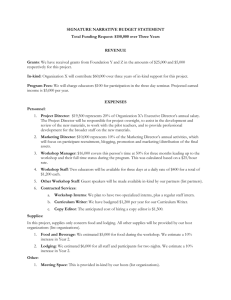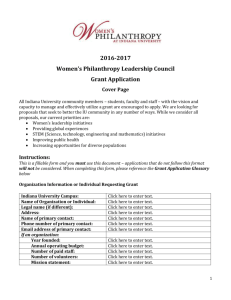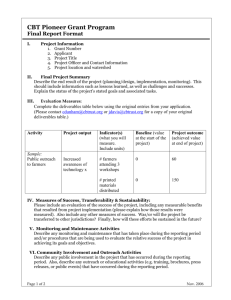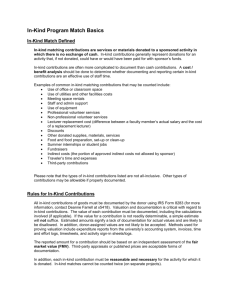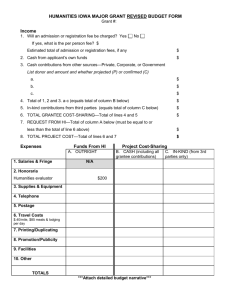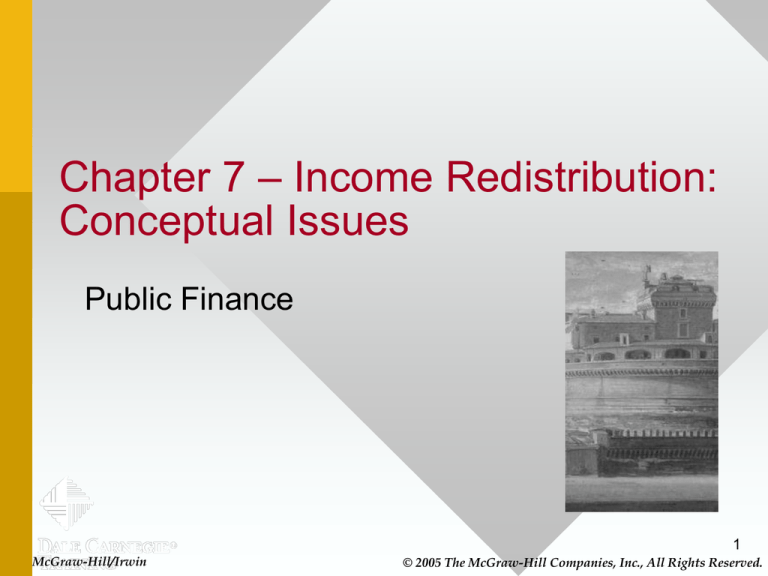
Chapter 7 – Income Redistribution:
Conceptual Issues
Public Finance
1
McGraw-Hill/Irwin
© 2005 The McGraw-Hill Companies, Inc., All Rights Reserved.
Introduction
• Will provide framework for thinking about
the normative and positive aspects of
government income redistribution policy.
2
Introduction
• Some question whether economists
should be concerned with distributional
issues.
– Value judgments embodied in the “right”
income distribution.
– No scientific basis for the “right” distribution.
3
Introduction
• Focus on efficiency alone has problems.
– That focus, too, is a value judgment.
– Multiple equilbria.
– Decision makers do care about the income
distribution; economic analysis ineffective if it
doesn’t consider this policy-maker constraint.
4
Distribution of Income
• Can analyze household income, and see
how equally or unequally the “pie” is
distributed.
• Table 7.1 shows the percentage of money
income among households for more than
30 years.
5
Table 7.1
Distribution of Income
• Richest 20% receives about 50% of total
income.
• Poorest 20% receives about 4% of total
income.
• Inequality has increased over time.
7
Distribution of Income:
Poverty
• The poverty line is a fixed level of real income
which is considered enough to provide a
minimally adequate standard of living.
• Inherently arbitrary, but still a useful benchmark.
– Trends over time
– Differences across groups
8
Distribution of Income:
Poverty
• Poverty line for a family of four was
$18,244 in 2001.
• Median household income more than
double that, $42,228.
• Table 7.2 shows poverty rates for
selected groups in 2001.
9
Table 7.2
Distribution of Income:
Poverty
• Poverty rates in U.S. in 2001 might be
considered surprisingly high – 11.7% for
population as whole.
• Concentrated among certain groups, such as
female headed households, children, and
minorities.
• Elderly have lower poverty rates than the U.S.
average.
11
Distribution of Income:
Poverty
• Can also look at trends over time.
• See Table 7.3.
• Poverty considerably lower than in 1960s,
but not much progress since 1970.
12
Table 7.3
Interpretation Problems
• Poverty line (and poverty rate) is subject
to a number of criticisms.
• When interpreting the numbers, it is
useful to know the conventions and
limitations.
14
Interpretation Problem #1
• “Income” consists only of cash receipts.
– Excludes in-kind transfers like health
insurance, food stamps, and housing.
• Would reduce poverty rate by more than 20%.
– Excludes non-market work such as childcare
or housework.
– Ignores income flow from durable goods.
15
Interpretation Problem #2
• Income is before tax.
– It ignores cash refunds from the Earned
Income Tax Credit, which has grown
dramatically in the last decade, and now
amounts to more than $31 billion annually.
– Ignoring this overstates poverty rates and
also affects the trends over time.
16
Interpretation Problem #3
• Income is measured annually.
• Not obvious what the correct time frame should
be.
– Income does fluctuate from year to year.
– Lifetime income considerations seem relevant.
– Consider a “starving” college student, for example.
Not really “poor” in a lifetime sense.
17
Interpretation Problem #4
• Unit of observation
– Person, family, household?
– People often make decisions as an economic unit, and
there are economies of scale in household production.
• Classifications can matter for poverty numbers
– Bauman (1997) calculates that including the income of
nonfamily members (such as nonmarried cohabitors)
would reclassify 55% of people who are poor out of official
definition.
18
Rationales for Income Redistribution
• Different kinds of social welfare functions
• Utilitarian
• Maximin criterion (Rawlsian)
• Pareto efficient
• Nonindividualistic
19
Simple Utilitarianism
• The utilitarian social welfare function is:
W F U1 , U 2 ,..., U n
Which depends on all n members of society.
One specific function form is:
W U1 U 2 ...U n
• This special case is referred to as an additive
social welfare function.
20
Simple Utilitarianism
• With the additive SWF that was given, also
assume:
– Identical utility functions that depend only on income.
– Diminishing marginal utility of income.
– Society’s total income is fixed.
• Implication: government should redistribute to
obtain complete equality.
21
Simple Utilitarianism
• This can be illustrated with two people.
• See Figure 7.1.
• Any income level other than I* does not
maximize the SWF.
• I* entails equal incomes.
22
Figure 7.1
Simple Utilitarianism
• Striking result is that full income equality should
be pursued, but some scrutiny required.
• Assumes identical utilities.
• Assumes decreasing marginal utility.
• Assumes total income fixed
– e.g., no disincentives from this kind of redistributive
policy.
24
The Maximin Criterion
• The Rawlsian social welfare function is:
W MinimumU1 , U 2 ,..., U n
• Social welfare in this case depends only on the
utility of the person who has the lowest utility.
• Rawls (1971) asserts it has ethical validity
because of the notion of original position.
– Notion that ex-ante individuals do not know where in
the income distribution they will be.
25
The Maximin Criterion
• These ethical claims are controversial:
– Still selfish view in original position
– Individuals extremely risk averse here
– All that is relevant is the welfare of the worstoff person, even if a policy is extremely
detrimental to everyone else.
26
Pareto Efficient Income Redistribution
• Suppose that utility of richer person does depend
on poorer person’s utility. That is:
U PETER U I PETER , U I PAUL
• Government redistribution in this case could
improve efficiency. It may be difficult for the
private market to do this, if, for example, the rich
lack information on just who really is poor.
• Simply an externality problem.
27
Pareto Efficient Income Redistribution
• Altruism plays a role in this example, but private
market could conceivable give charity.
• But not just altruism. Self-interest could play a
role. Suppose there is a possibility that, for
circumstances beyond your control, you become
poor.
– When well off, pay “premiums.” When bad times hit,
collect “payoff.”
– Motivation of some social insurance programs.
28
Nonindividualistic views
• In previous cases, social welfare derived from
individual’s utilities.
• Some specify what the income distribution
should look like independent of individual
preferences.
• One example: commodity egalitarianism.
– Right to vote, food, shelter, education, perhaps health
insurance.
29
Processes versus Outcomes
• Some argue that a just distribution of income is
defined by the process that generated it.
• For example, “equal opportunity” in U.S.
– Ensuing outcome would be considered fair, regardless
of the income distribution it happened to entail.
– Fair bit of income mobility (Gottschalk, 1997).
• Does raise problem of how to evaluate social
processes.
30
Expenditure Incidence
• Relative Price Effects
• Public Goods
• Valuing In-Kind Transfers
31
Relative Price Effects
• Suppose government subsidized housing of the
poor.
– As a first pass, redistribution from rich to poor.
• May have overall effects on housing prices
– Landlords may reap part of gain.
– Affects wages of construction workers.
• Generally, any government program sets off a
chain of price changes, and the incidence is
unclear.
32
Public Goods
• Do rich and poor benefit similarly from the
provision of public goods?
• Difficult to measure, sensitive to assumptions
that are made.
33
Valuing In-kind Transfers
• Government provides many benefits to the poor
in-kind – that is, direct provision of goods rather
than cash.
– Food stamps
– Medicaid
– Public Housing
• Estimating value is difficult. Not always valued at
dollar-for-dollar (if resale is difficult).
34
Valuing In-kind Transfers
• Consider how the provision of an in-kind benefit
changes the budget constraint in Figure 7.2.
• In this case, giving an in-kind benefit lowers utility
relative to an equally costly cash transfer.
• Although the person is better off by having the inkind transfer than not having it, she would be
even happier with the cash transfer.
35
Figure 7.2
Valuing In-kind Transfers
• A person can never be made better off with an inkind transfer that is equal in cost to a cash
transfer.
• There are instances, however, when a person is
indifferent between the two transfer schemes.
• See Figure 7.3.
37
Figure 7.3
Valuing In-kind Transfers
• In this example, giving the transfer in-kind is not
binding.
39
Numerical Example: Baseline
• Assume that Jones has the following utility
function:
1
4
U uC, O C O
3
4
• Where C indicates the quantity of cheese
consumed, and O indicates the quantity of other
goods.
• Jones faces prices PC=2 and PO=1 for cheese and
other goods, respectively.
40
Numerical Example: Baseline
• What allocation of would Jones choose with
I=300 ?
• In this Cobb-Douglas utility function, Jones’
demand curve for cheese is:
I 14 300
C
37.5
1 3
PC 4 4 2
*
41
Numerical Example: Baseline
• In addition, Jones’ demand curve for other
goods is:
3
300
I
*
4
O
225
1 3
PO 4 4 1
• Jones’ utility is therefore equal to:
1
4
3
4
U 37.5 225 143.76
42
Numerical Example: Cash Transfer
• In addition to Jones’ initial income, assume the
government gives a cash transfer of $120.
• What consumption bundle does Jones now
choose, and what is her utility?
I 14 420
C
52.5
1 3
PC 4 4 2
*
43
Numerical Example: Cash Transfer
• In addition, Jones’ demand curve for other
goods is:
3
420
I
*
4
O
315
1 3
PO 4 4 1
• Jones’ utility is therefore equal to:
1
4
3
4
U 52.5 315 20126
.
44
Numerical Example:
Binding In-kind Transfer
• In addition to Jones’ initial income, assume the
government gives an in-kind transfer of 60 units
of cheese, which she cannot resell.
• What consumption bundle does Jones now
choose, and what is her utility?
45
Numerical Example:
Binding In-kind Transfer
• Note that the in-kind transfer costs the
government $120 (60 units x $2 per unit).
• When Jones was unconstrained, she used the
extra $120 to arrive at an allocation of
{C,O}={52.5,315}.
• Jones cannot attain this, because the minimum
amount of C she can consume is C=60 (the
amount of the in-kind transfer).
46
Numerical Example:
Binding In-kind Transfer
• Thus, she uses all of her fungible income
($300) to purchase the good O:
I 300
O
300
PO 1
*
• Jones’ utility is therefore equal to:
1
4
3
4
U 60 300 200.62 20126
.
47
Numerical Example:
Nonbinding In-kind Transfer
• In addition to Jones’ initial income, assume the
government gives an in-kind transfer of 30 units
of cheese, which she cannot resell. In addition
the government also gives a cash transfer of
$60.
• What consumption bundle does Jones now
choose, and what is her utility?
48
Numerical Example:
Binding In-kind Transfer
• Note that the total transfer costs the government $120.
The in-kind transfer costs the government $60 (30 units x
$2 per unit), and the cash transfer costs another $60.
• When Jones was unconstrained, she used the extra $120
to arrive at an allocation of {C,O}={52.5,315}.
• Jones can attain this, because the minimum amount of C
she can consume is C=30, which is less than C=52.5 (the
amount of the in-kind transfer).
49
Numerical Example:
Binding In-kind Transfer
• Thus, she uses part of her fungible income ($360) to
purchase the good C and good O.
• Ultimately, she wants C=52.5, so she purchases 22.5
units of C with her fungible income (with the rest coming
from the in-kind benefit).
• She purchases 315 units of O with the remainder of her
fungible income.
• Utility is the same as the unconstrained case.
50
Valuing In-kind Transfers
• Why give in-kind transfers if they tend to be
inefficient?
– Commodity egalitarianism
– May reduce welfare fraud (especially if the in-kind
transfer is an inferior good)
– Politically viable because they help the producer of the
in-kind good.
51
Recap of Income Redistribution:
Conceptual Issues
• Distribution of income
• Poverty line
• Social welfare functions
• Valuing In-kind transfers
52

